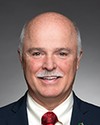I do have opening remarks. The member will have to wait a few minutes.
Thank you, Mr. Chair.
I would like to begin by recognizing that we are meeting on the traditional unceded territory of the Algonquin Anishinabe people. I am grateful for the contributions and stewardship of indigenous peoples across Canada, who for generations have cared for the lands they call home.
We are here to discuss the findings of six reports that my office released this morning. This release also includes a message to mark the halfway point in my 10-year mandate as Auditor General of Canada.
I will begin with our audit of the Canada Revenue Agency’s contact centres, and whether they provide Canadians with timely and accurate information about personal taxes, benefits and business taxes.
The Canada Revenue Agency has a duty to help individuals and businesses meet their tax obligations and access benefits. I am concerned that in spite of a new call system and other improvements, Canadians are still waiting too long to get answers to their tax questions.
During the last fiscal year, callers choosing to speak with an agent waited on average 31 minutes, twice as long as the agency’s service standard of 15 minutes. When callers did reach an agent, they were often provided with inaccurate information.
Auditors from my office placed calls to contact centres and asked general or non-account-specific questions. We found that agents' responses to individual tax questions were accurate only 17% of the time and that business tax or benefit questions were accurate just over half of the time.
To test the accuracy of agents' responses to account-specific questions, we reviewed a sample of recorded conversations. We found that the accuracy was much higher when questions pertained to specific accounts.
Turning now to our two audits of programs related to the Canadian Armed Forces, the first focused on whether the forces recruited and trained enough members to meet operational requirements. Between 2022 and 2025, the Canadian Armed Forces fell short of their target by about 4,700 recruits. Though the forces were able to attract thousands of applicants, only one in 13 started basic training.
The Canadian Armed Forces did not always know why applicants abandoned the recruitment process. Without this knowledge, the Canadian Forces are not able to determine what needs to be done differently to increase the number of successful candidates.
The armed forces also did not have sufficient basic training capacity to meet demand if the recruitment targets had been met. Challenges attracting and training enough highly skilled recruits to staff many occupations, such as pilots and ammunition technicians, could affect the army, navy and air force’s ability to respond to threats, emergencies or conflicts and accomplish their missions.
Our second audit related to Canada's military forces focused on housing. Overall, we found that National Defence did not manage living accommodations to meet the operational requirements or respond to the needs of the Canadian Armed Forces members and their families. National Defence did not have enough living spaces at the right locations, including quarters that met its own standards for living space per person. We also found that some buildings were in poor condition, lacking such basic amenities as safe drinking water and working toilets.
In addition, the Canadian Forces Housing Agency—which manages residential housing units on bases—did not plan to build enough new housing units to fill existing gaps. Canadian Armed Forces members can be required to move frequently, so it is important for their morale and well‑being that they can access affordable housing in good condition, with sufficient living space for themselves and their families.
I will now move on to the audit for examining whether the federal government had the tools in place to protect its IT networks and systems against cyber-attacks. While the government did have a comprehensive strategy, there were gaps in some areas, such as cybersecurity defence services and responses during active cyber-attacks.
Next, 58% of federal organizations are not required to use the cybersecurity defences offered by Shared Services Canada and Communications Security Establishment Canada. Though some have opted in, this inconsistent use of services has resulted in a fragmented cybersecurity landscape that could undermine the federal government's ability to protect critical information and manage risks.
We also found that coordination among the Treasury Board of Canada Secretariat, Communications Security Establishment Canada and Shared Services Canada was too slow during active cyber-attacks. Slow coordination and limited information sharing during a recent major attack delayed the government's response, extending the time during which the attacker had access to public servants' personal information.
Malicious actions, external events and attacks involving the Canadian government's digital systems are becoming more sophisticated and frequent.
A coordinated and comprehensive approach to the government's cybersecurity position, improved collaboration and an up-to-date inventory of IT assets are critical to protecting Canadians' information and maintaining their trust in government IT systems.
Let's move on to the audit that looked at whether Employment and Social Development Canada fulfilled its responsibilities to support early learning and child care across Canada.
The federal government committed $35 billion to provinces, territories and indigenous partners over five years to support the creation of affordable and accessible child care spaces. As of March 2024, parents' out-of-pocket fees for federally funded spaces had been reduced to an average of about $16.50 a day.
Federal funding also supported the creation of approximately 112,000 new child care spaces as of March 2024. However, with less than two years left, there is a risk that the goal of creating 250,000 new spaces will not be met.
Important progress has been made in bringing down child care costs to parents. However, Employment and Social Development Canada needs to collect consistent and comparable data across the country to track the program's overall performance, inform future decisions and support Canadian families.
In our last audit released today, we followed up on Indigenous Services Canada's progress to address 34 recommendations from six audits conducted since 2015.
Programs to first nations are a decades-long concern for my office. Despite the almost doubling Indigenous Service Canada's spending on programs over the last five years, we found unsatisfactory progress on more than half of recommendations to address long-standing issues critical to the health and well-being of first nations communities. Twenty years after my office first identified concerns with drinking water quality in first nations communities, 35 long-term advisories remain in effect, including nine that have been in place for a decade or longer.
Our audit also found that there are fewer emergency services agreements in place today than there were in 2022. These agreements are essential for timely, coordinated responses to events such as wildfires and floods, while mitigating the disruption to people's lives and damage to critical infrastructure.
Sustained focus at Indigenous Services Canada to rethink how it delivers programs, while collaborating with first nations to improve their capacity, is an important step in resolving the persistent issues, improving outcomes and advancing reconciliation.
As I look ahead to the second half of my mandate, my unwavering goal remains that my office will continue to provide non-partisan, fact-based information to parliamentarians and the federal public service so that they can more easily adjust and best direct resources towards outcomes that serve the diverse needs of Canada's people. The intention is to be constructive and focused on the pursuit of excellence and accountability in the public service. This has been the focus of my first five years leading the Office of the Auditor General of Canada, and it will remain my focus for the next five.
Thank you.




